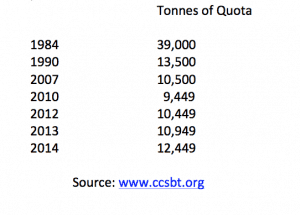Each year the CCSBT Scientific Committee meets and assesses the status of the stock. That Committee includes scientists from each Member country and six (6) international scientists who make up an independent External Panel, and who provide the independent Chairs of the scientific assessment groups – see www.ccsbt.org.
The Scientific Committee annually advises the CCSBT Commission meeting on the stock status. The Commission consists of the Member Governments – and its decisions must be reached by consensus.
The Commission then sets the global quota and allocation between countries. The global quota has moved as follows:

Calculating Quotas
Two key inputs are used to calculate the total allowable catch (TAC) formula for the SBT fishery. The first is the catch per unit of effort, which is an indicator of the current abundance of older fish. This is measured by the number of fish caught per 1000 hooks (adjusted for the season, the location and the vessels).
The data for this indicator is taken from the Japanese longline fishery, which covers the widest area of all the fisheries and represents a continuous time-series dating back to the late 1950s. But catch-per-uniteffort rates are not always a direct indicator of the number of fish – they can vary dramatically according to the fishing location, the season and the ships collecting the data.
The second input is the data collected during an annual aerial survey of juveniles in the Great Australian Bight, where most juveniles spend their first two to three summers before dispersing across the southern oceans. This is an indicator of how many juvenile fish are coming up through the system to replenish the adult population in the future.
Different management procedures using these two inputs’ data series are tested using an operating model, or ‘virtual reality’, of the SBT stock and fishery. This allows for a range of scenarios to be tested to select the best performing strategy – that is, the one that still achieves the rebuilding of the stock despite the worst-case scenarios.
Among the operating model contributes an increasing database of information on migration habits and productivity patterns drawn from a suite of projects pioneered by CSIRO in recent years to develop a deeper understanding of SBT.
Article Reference: FISH News, Fisheries Research and Development Corporation, Volume 20 Number 4, December 2013, pp 16-20.Current Decisions to Guarantee Sustainability of SBT Stock.
International decisions guarantee the sustainability of SBT
The CCSBT has made two major decisions to guarantee the sustainability of the Southern Bluefin Tuna stock:
- From 2011, the quotas are based on the scientific Management Procedure (MP’s). An MP is a mathematical formula which fixes the global quota at the level required to ensure the stock is sustainable. This means the quota can increase or decrease – depending on the trends in the two stock Indicators used in the MP (ie the Australian scientific aerial survey, and Japan’s longline catch rate).
- The compliance systems in all countries have been tightened to where every individual SBT has its own individually numbered tag. This tag is supported by an audit trail of documents and observers.
More Facts About Southern Bluefin Tuna Sustainability
- Commission for the Conservation of Southern Bluefin Tuna
- Management of Southern Bluefin Tuna in Australia
- Ranching Sustainability under the SA Aquaculture Act
- SBT Are Often Confused With Other Tuna Species
- Strict Monitoring of Individual Tuna
- Tuna Breeding Stock Larger Than Quota Baseline
FAQs About SBT Sustainability
